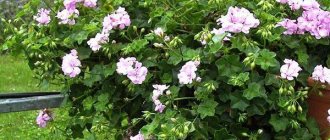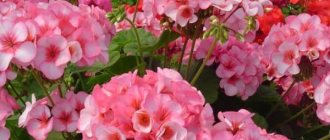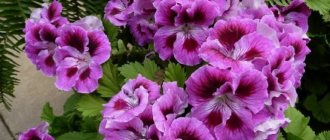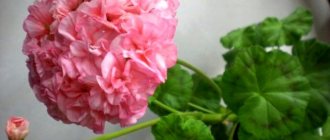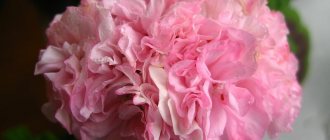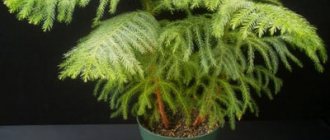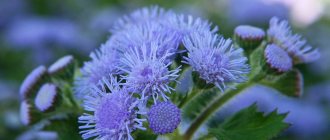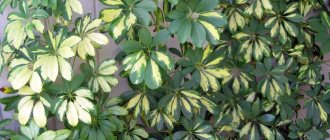Today we will talk about rolls or geraniums (pelargonium), which have been the most famous and popular home ornamental plants for many years. I also have such flowers in my flower collection, and over time I began to grow quite a lot of varieties.
The rolls are very unpretentious, the flowering is magnificent, and care is quite simple. Of course, there are some peculiarities in care, but they are simple, and even a novice gardener can grow such a plant. I want to share my experience of caring for rolls or geraniums at home.
Types of pelargonium
The genus Pelargonium unites about 250 species of different plants of the geranium family. Among them there are herbaceous ones, as we are used to seeing them, and shrubs. The plant called geranium is classified as a separate genus. But often the indoor flower pelargonium is called geranium. The name of the flower comes from the Greek word “pelargos”, which means “stork”. After all, its flowers resemble the head of this bird. We usually call it a kalachik. This is probably due to the round shape of the leaves.
All numerous types of pelargonium, or kalachik, are conventionally divided into:
- ampelous;
- bush: flowering;
- fragrant.
The hanging ones grow downwards, the bush ones - upwards.
Zonal Kalachiki are plants with beautiful flowers that can have 5, up to 8 (semi-double) or more (double) petals.
Sometimes it's hard to believe that these are all balls. Flowers (photo) can be of a wide variety of shapes.
They are collected in a hemispherical umbrella. Various colors: from white, salmon, pink to burgundy, almost black. There are only pure yellow and blue balls. Flowers are often two colors. In this case, their location can be like this:
- inside – light, outside – darker;
- rim around the edge of the petal;
- different petals are painted in different colors.
The leaves can also be monochromatic or with multi-colored zones (that’s why the ball is called zonal). They can even be three colors. Varieties with very brightly colored leaves are classified as a separate subspecies. Their colors can be red, brown, yellow, white, purple.
Royal (English grandiflora) flowers are so large that they reach a diameter of six centimeters. They, like a princess, require special care. In winter, they need to be illuminated, and the temperature should not be higher than 10 degrees, otherwise flower buds will not form. And they bloom for only 3-4 months.
Rolls of this species are distinguished by dark burgundy spots or dark stripes near the veins on the lower petals.
Kalachiki "Angels" have flowers similar to violas. The 30 cm tall bush blooms all summer.
Many pelargoniums have a strong odor. This flower is called fragrant pelargonium. It blooms with small purple or pink flowers. All its charm lies in its dissected leaves, which smell like mint, lemon, lilac, pine needles, pineapple, roses and many other aromatic plants. Geranium oil is extracted from the leaves of this plant.
Ampelous rolls have stems up to a meter long with small ivy-like leaves and multi-colored buds.
There are also succulent balls, but they are not common here. They are used to create bonsai-style compositions.
The geranium bush grows in height from 10 cm (miniature) to 60 centimeters. But it can be higher, reaching 80 cm (airines). There are also microminiature rolls, the height of which is less than 10 cm.
The plant blooms in our latitudes from late March to November.
Description of geranium
Geranium belongs to the Geranium family. Homeland - South America. Perennial evergreen plant.
Pelargonium got its name from the Greek word pelargos - stork, for the similarity of the shape of the fruit to the beak of a stork.
Geranium is one of the most beloved plants by gardeners. The flower is very popular in many countries of the world. It is grown on window sills, balconies, and in countries with warm climates - in flower beds.
Geranium has one interesting feature: it gets along well in the same pot with other indoor flowers, for example, roses.
Its bushes can perfectly complement many exotic plants. The leaves come in a variety of shapes and colors.
Geranium flowers are large, collected in umbrella-shaped inflorescences of various colors.
The plant is light-loving, relatively drought-resistant, and grows well in light, fertile soils. There are a large number of species, races and varieties in culture.
Reproduction
Kalachik is a flower that is easily propagated by cuttings. They are broken off or cut off from the side branches or tops. The length of the cutting should be from 5 to 7 centimeters and have at least two leaves. Plant immediately in a permanent place in light soil. The cut area is treated with ash.
You can take cuttings all year round. But it is better to do this in the spring - in March or April, and in the fall - in August and September.
Cuttings help improve the appearance of the plant. If it is very long and the flowers are placed only at the top, cutting off the top causes the growth of lateral shoots from dormant buds. Later they will be covered with flower stalks.
Withered flowers are removed so that new ones can form as quickly as possible.
Care
Water the plants as the soil dries out. Kalachik is a flower that loves moisture, but it should not be flooded. In summer, the ball is watered more often, and much less frequently during the dormant period. But still, the soil must be constantly moist.
Excess moisture comes out through the pan. But the drainage in the pot must be of high quality.
The roll does not need to be sprayed. He loves dry air.
Kalachiki are indoor flowers. But in summer they feel better in the fresh air.
And feeding them won't hurt. It is carried out once every two weeks with liquid complex mineral fertilizer. You can use the “Bud” product.
We care for rolls (geraniums, pelargoniums)
As already mentioned, care is the simplest and minimal, but if you do everything correctly, the plant will bloom constantly and will have a healthy appearance and a lush crown.
Place
- The main rule is that there should be a lot of sun, the south side is the ideal place for the plant. Only on very hot and dry days can you shade the window a little so that the leaf plates do not get burned.
- If you place the plant in the shade or in a damp corner where windows open and there are drafts, the balls will react with yellowing leaves and a lack of flowering.
Watering
It is strictly not recommended to water the rolls with cold tap water containing a high content of chlorine and lime. Only warm water is used, which is pre-settled. You can use filtered.
During the autumn and winter months, watering is carried out several times a week as the top layer of soil dries. On hot summer or spring days, water the soil in the pot daily. But you can’t overfill it, so that the root system doesn’t start to rot.
Be sure to make a drainage layer in the flowerpot where the geranium grows so that moisture does not stagnate in the root system. The pot is not very large in size. It is necessary that the roots completely occupy the entire volume. In a pot that is too large, the flower will not bloom until the root system grows.
Humidity
- This plant does not tolerate spraying or showering. Also, do not wipe the foliage with wet wipes. This procedure can only be carried out very rarely when the flower becomes too dusty. High humidity has an extremely negative effect on the rolls.
- If there are plants nearby that need increased moisture and spraying, then try not to get on the geranium.
Temperature
Kalachiki grow well at normal room temperature throughout the year. In the autumn - winter period, the air temperature should be within +10 - 15 degrees. It is worth moving the pot with the balls to the windowsill or to a room that is not so heated.
Fertilizers
- It is strictly not recommended to add organic matter to the soil. Geranium tolerates it extremely negatively.
- During the growing season (growth and flowering), you need to apply fertilizers for indoor flowering plants. The scheme is no more than several times every 30 days.
- Fertilizers are applied in liquid form. It is advisable to combine it with watering.
- During the development period and for longer and more abundant flowering, you can use the following feeding recipe: dissolve 1 drop of regular iodine in 1 liter of water. You need to water along the walls of the pot so as not to burn the root system.
Trimming
- This procedure is usually carried out in the autumn. Leave shoots that should have only 6 - 8 leaves.
- It is necessary to remove branches that grow not from the soil, but from the axils of the leaf blades.
- In the third ten days of February and until the beginning of March, pruning can also be done. Remove the branches and leave only a few buds on the shoots.
- Use the branches that you cut for propagation. Makes excellent cuttings.
- If you want to make the bush of balls more luxuriant and denser, pinch out the top parts of the branches, leaving 4 - 5 leaves.
- In winter, pruning is not carried out.
Application
The fragrant roll has bactericidal substances. While in the air, they kill many pathogenic microbes and even staphylococcus.
Fragrant pelargonium helps treat sore throat. For this, an infusion of leaves is used.
For otitis media, geranium leaves are kneaded and a compress is applied to the ear, which relieves pain and reduces inflammation.
The same compress, but with more leaves, is applied for radiculitis or osteochondrosis.
The smell of the fragrant roll has a beneficial effect on patients with neurasthenia, hypertension, heart and stomach diseases, and suffering from insomnia.
But its main purpose is to decorate our lives. As soon as the threat of frost has passed, a huge number of rolls of all kinds and colors appear on city streets.
They are used to decorate balconies, flower beds, and ridges.
Features of caring for a houseplant in autumn and winter
For abundant and lush flowering of pelargonium, it is necessary to provide an adequate rest period. In the cold season, it is recommended to keep the flower at a temperature within 12-15 °C. In autumn and winter, when daylight hours become shorter, light-loving pelargonium needs additional artificial lighting with the help of phytolamps.
It is necessary to prepare the plant for the dormant period in the fall. To do this, all sickly and yellow leaves are removed, and the flower pot is moved to a place with good lighting. Additional lighting will preserve the decorative qualities of the shrub and ensure intensive flowering in the spring.
Remember!
When caring for Kalachik in the cold season, the main thing is to avoid a discrepancy between the temperature and the amount of lighting: the warmer it is, the more light, and vice versa.
Also at this time of year it is necessary to reduce the frequency of watering and stop applying fertilizers. However, if the flower is kept in a warm room, there is no rest and it is not recommended to reduce the amount of watering, as this will lead to deep drying of the soil. The plant does not tolerate exposure to cold air, so it should be removed from the windowsill when ventilating the room.
Why doesn't the little ball bloom?
- This may be because the room is too warm in winter and the flower cannot enter a dormant state. Therefore, it continues to produce leaves rather than flower stalks.
- Due to damage by mites, weevils and other pests or gray rot.
- Due to improper watering. From excess moisture, the plant rots and withers. With its deficiency, the leaves dry out.
- Root damage by fungal and bacterial diseases.
- A very large pot.
Among these causes, diseases and pests are of particular concern. Without eliminating them, the ball will disappear.
How to replant rolls
The flower does not really need such a procedure. In addition, the rolls do not like to be transplanted, so this event should not be carried out too often and unless absolutely necessary.
The plant needs to be replanted only when the roots begin to peek out of the pot. It is recommended to plant or replant a flower only in the first half of spring, when the growing season begins.
Choose a new pot that is only a few centimeters larger than the previous one. In a pot that is too large, flowering will not occur soon.
Be sure to place a layer of drainage at the bottom of the flowerpot, and then fill it with regular universal soil for flowers. You can only use garden or vegetable soil.
Some gardeners use this option:
- turf soil - 8 shares;
- humus - 2 shares;
- river sand - 1 share.


